ESPIONAGE COLLECTION
CAMERAS IN ESPIONAGE
Before the spy camera business grew, crime scenes were recorded by daguerreotype photography. These cameras could capture scenes, but nothing was small enough to be carried around in the pocket or advanced enough to capture still images of motion. This was until the famous Minox subminiature camera, first devised in 1922. Nearly a century after the photograph was invented, the spy camera was conceived. Some of the first secret cameras were designed by Walter Zapp in Germany between 1937 and 1943.
During World War II, agencies were interested by the small size and macro focusing capacity of the spy cameras for inconspicuous use in surveillance and document copying.
Spy cameras became a luxury item and were commonly used as an espionage tool in the Cold War, whilst production was developing technologically, also creating a number of accessories. Spy Camera accessories such as tripod mounts and flash guns allowed users to branch out into more complex forms of photography.
Pigeons were also used to carry small cameras in order to inconspicuously capture satellite images. The first known aerial photographs were taken by Nadar in 1858 during a hot-air balloon flight. A novel idea in terms of taking photographs from the sky appeared about 40 years later: a small camera specifically designed to be carried by a pigeon, inconspicuously capturing satellite images.
Wilhelm Neubronner, a pharmacist from Kronberg in Germany, had carrier pigeons that brought him urgent prescriptions. His son Julius continued this practice. In order to verify the route taken by one of his pigeons, he designed a small device, which could be fitted to the bird’s chest using elastic straps. Patented in 1903, this camera took several snapshots on film that is 4 cm along each side using a delayed-action automatic trigger.
Around 1910, Julius Neubronner designed a second camera: the Doppel-Sport. It took a single panoramic image on a curved 3x8 cm negative with a rotating lens, activated by a delayed-action trigger.
In the 1930s, Christian Adrian Michel, the Swiss owner of a watchmaking parts factory in Aargau, designed a camera adapting the Doppel-Sport to use 16 mm movie film. The camera, which was never a commercial success, was equipped with a timing mechanism, which ensured the delay of the shot being taken, the moving of the film and the interval between photographs.
Eastman Kodak, a leader in the standard photography industry, produced a camera to fit perfectly inside of a matchbox, which the U.S. Office of Strategic Services used during World War II. In the 1940s, the Steinbeck ABC Wrist Watch Camera was released, which soon became a highly sought after item. However, the face of the watch quite clearly contained a lens if you looked closely. By 1960, F21 also known as AJAX (part of Laterna Magica Museum collection) cameras were in use by KGB agents. The lightweight camera was concealed in a coat button. All the agent had to do was press a button from a release shutter in his pocket, and the front of the camera would quickly open as the camera took a photo. German Stasi agents also used the famous briefcase cameras in the 1970s and 80s, which allowed them to shoot images in infrared to expose low light condition.
TRICKING THE MASSES
As the popularity of spy cameras grew, companies began making products to look as though they contained spy cameras (for instance the miniature model camera as a lighter - part of Laterna Magica Museum collection). The Kiev John Player was a pack of fake cigarettes fitted with tiny cameras, created as trick gifts for gullible tourists, passed off as used by the KGB agents. It did, however, work, if you knew how to use it.
Today, secret camera technology has progressed significantly from its roots, but some vintage models are still available to collectors, such as the Minox B, EC, MX, TLX, Lite lighter camera, Expo watch camera and DSC. With the advent of digital photography in the 20st century spy cameras have evolved to be able to digitally record still and moving images, as well javascript:void(0)as sound. Recently spy cameras have developed to use 3G spy camera technologies to allow users to record from anywhere in the world.
More people are using spy cameras every day as they become increasingly technologically advanced. Now, hidden cameras are totally unnoticeable and able to perform a variety of tasks to allow users to find out anything they need. The UK today currently is using 4.2 million CCTV cameras across the country. Covert cameras can be hidden in objects from glasses and pens to clocks, and are available for use by employers, employees, members of the police force and the general public.
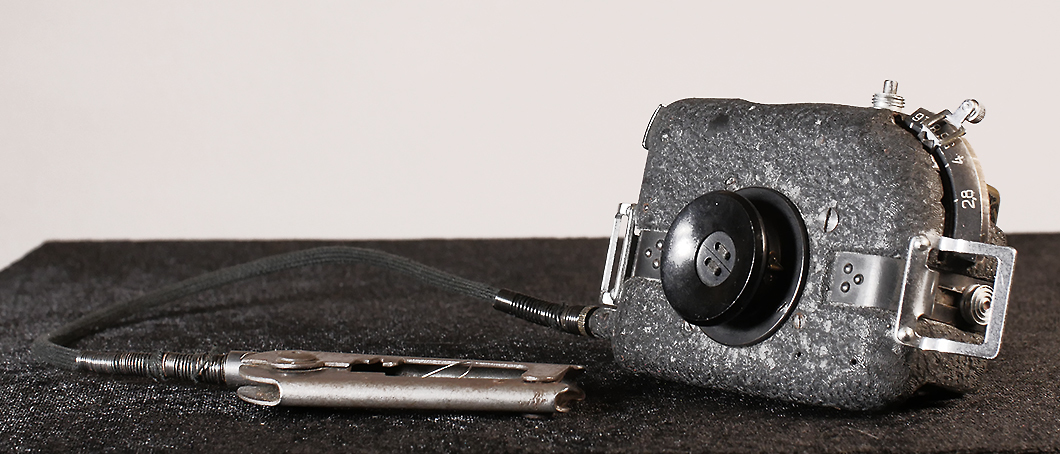
Russian F-21 Button Camera, ca. 1950. LATERNA MAGICA Museum Collection.
First Covert Button Camera
The very first covert button cameras were custom made by the American, Russian and British intelligence services in the 1950s. Used by intelligence agencies during the cold war in the 1950's and 1960's, the world's first button camera could only take still shots and was so bulky, it had to be disguised under a heavy coat.
The actual button was a plate that screwed onto the camera lens of a small subminiature camera. The button camera plate had a cord that ran into the agent's pocket. When an agent wanted to take a still photo, he simply placed his hand in his pocket and pushed the lever. The center part of the button would quickly slide away to expose the camera lens and the shutter would open.
The coat used had to have the button camera installed on it with matching buttons as well as a hole torn inside the coat pocket so the camera lever could be installed.
Since the exposure was done on small subminiature 16 mm film, one had to develop the film before one could see the results of the efforts. Most agents had their own film developing kits.
There were hundreds of these still cameras used mainly by federal intelligence agents such as CIA and KGB agents. No one knows exactly how many of these button cameras where made but they are very rare today.
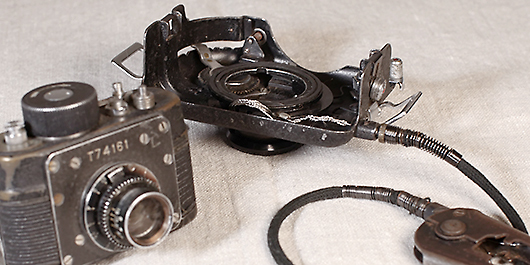
Inside of Russian F-21 Button Camera, ca. 1950. LATERNA MAGICA Museum Collection.
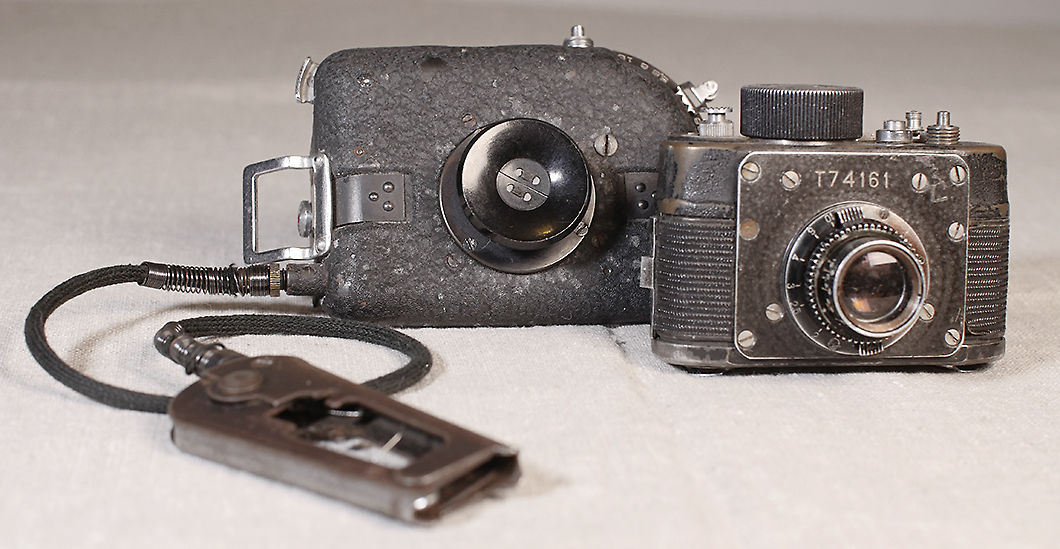
Russian F-21 Button Camera, ca. 1950. LATERNA MAGICA Museum Collection.
Above is the inside of the button cover. It screws onto the subminiature camera lens. Notice the back side of the center of the button and the strings coming in. When the hidden lever was pushed in, the strings would quickly pull down the doors on the center of the button and a snapshot would be taken.
The cord provided the lever that went into the pocket to take the covert snap shot. A trench coat had to be modified with buttons and holes in the back to bring the cord into the trench coat pocket.
Expo Watch Camera
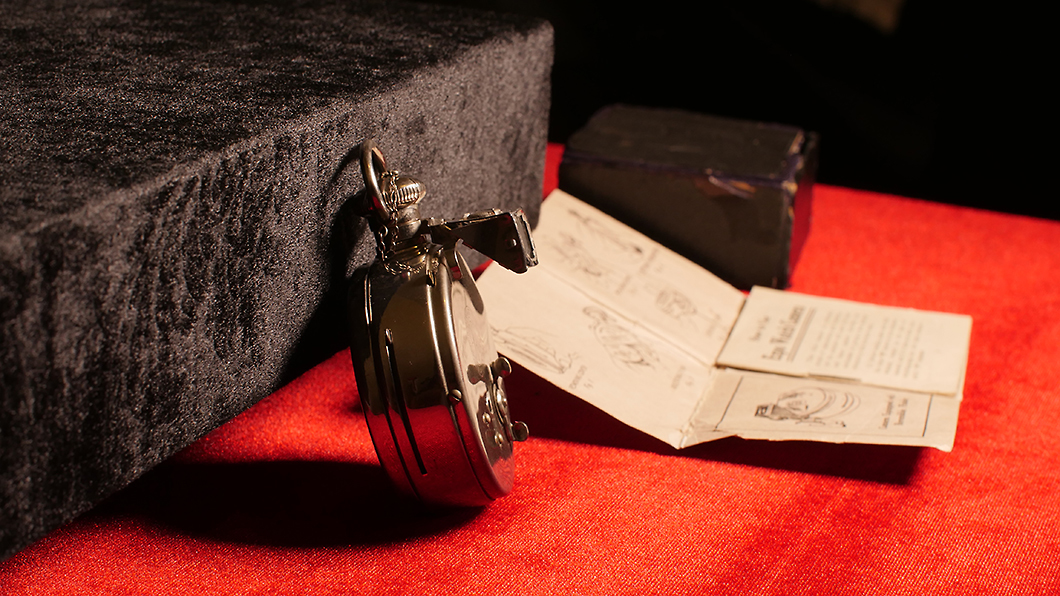
Expo Watch Camera, ca. 1905. Laterna Magica Museum Collection.
The Expo Watch Camera, a sub-miniature camera shaped like a pocket watch, was designed by Swedish engineer Magnus Niéll and made in the USA.
Designed to be small, easily carried and mistaken as a pocket watch, the watch camera was a popular novelty, or disguised camera, of the early 1900s. The camera measures 2 1/8 x 7/8 inches and weighs 2 3/4 ounces. The camera was available for over three decades. It was introduced in the United States in 1905 and offered for sale as late as 1939.
Although this looks like a man's watch, it is a camera. The watch winder is effectively a lens cap. The round button protruding from the side of the casing is the shutter release.
The camera also has a slot with a protruding metal tab. Pulled half-way along the slot, the tab opens the shutter for time exposure. Pulling the tab fully along the slot arms the shutter for instantaneous shots.
The shutter is not self-capping, meaning that arming the shutter exposes the film. Thus, it was necessary to keep the cap on the stem until the shutter was armed. Once the shutter was armed, the cap could be removed and the shutter release pressed to make the exposure.
Ticka Watch Camera
After the introduction of the American Expo Watch Camera, the Ticka Watch Camera was made in England by Houghtons. Both were designed by Swedish engineer Magnus Neill with the notable difference between them being the engravings and monogram.
The watch cameras are slightly thicker than a pocket watch of the same era and about as wide. The lens is at the top and has a cap that is disguised as the wind-up knob of a watch. It has a metal ring for attaching it to a carrying chain.
The Ticka uses a special 17.5mm roll film - loaded in cassettes - taking 25 16 x 22mm images. An accessory viewfinder was available which slid into a groove on the "stem".
The body of the camera was made of nickel-plated brass and had the letters HTC engraved as a monogram at its back. In 1906, there was even a limited edition, made in solid silver, one of which went to Queen Alexandra who was a keen amateur photographer. It was engraved with the Royal Crest and her monogram 'A'. A later version of the Ticka has a dummy watch face, with the hands indicating the angle of view.
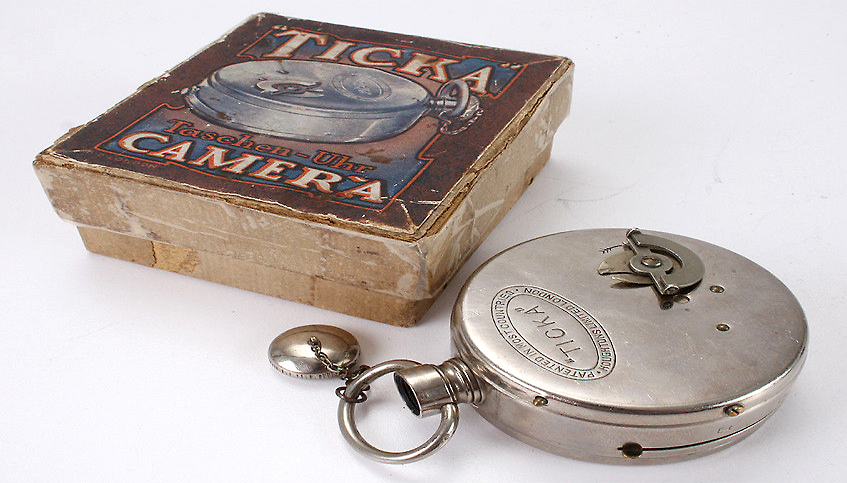
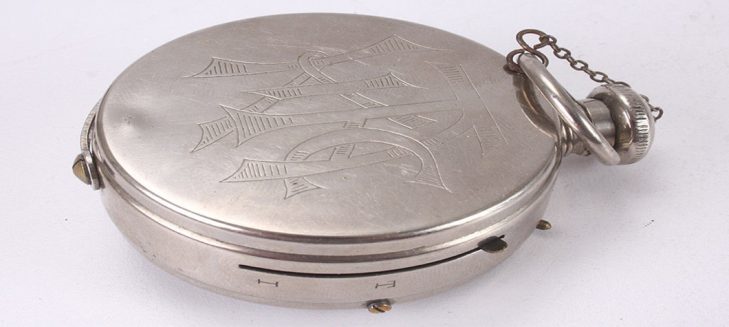
Spy Kit Briefcase
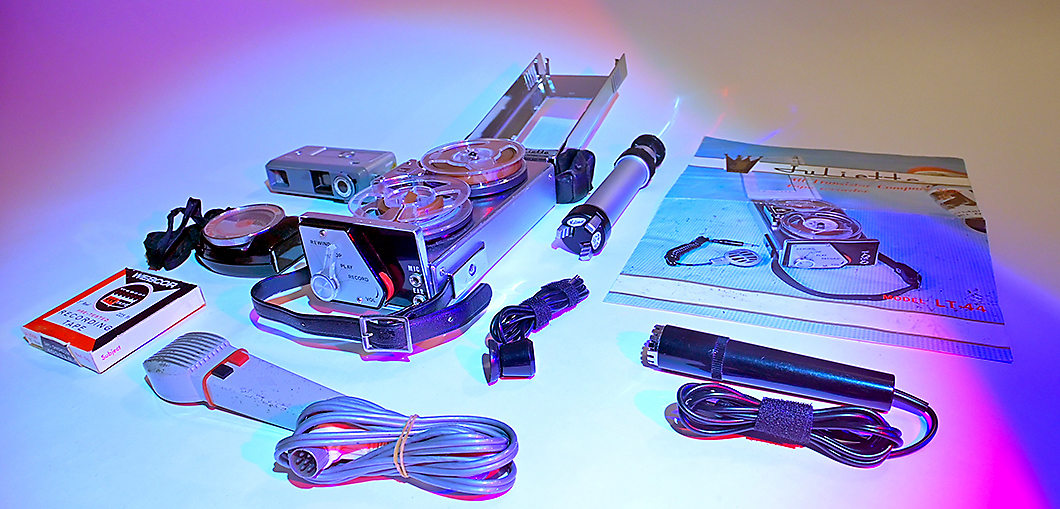
The Samsonite Spy Kit briefcase from 1969, New York City, was acquired from its original owner, a UFO enthusiast. The accompanying recording captures him discussing how UFO researchers have long claimed that recovered UFOs have been studied. He highlights what he sees as a significant confirmation—an open statement in The New York Times acknowledging that airspace authorities are in possession of materials from recovered UFOs.
The Spy Kit includes a recorder, camera, mini tripod, microphone, headphones, and a light meter—all neatly housed in a Samsonite briefcase—and is part of Laterna Magica Museum’s spy collection.
Transcript of recording on the Spy Kit, New York City, 1969
"UFO researchers have long claimed that recovered UFOs have been studied, and now we have what appears to be an open statement in The New York Times—a publication often regarded as a voice of the establishment—acknowledging that airspace authorities are handling materials from recovered UFOs. That’s essentially what this article is stating.
However, what they don’t disclose are the conclusions. What are these metal alloys? What are these materials? The article remains deliberately vague and silent on those details.
It is absolutely necessary for researchers to file requests to uncover what conclusions have been drawn. Or perhaps someone like Bigelow himself might step forward and make the findings public—that would be significant. We’ll discuss that further on my program.
Testing. One, two, three, four, five, six. Testing. One, two, three, four, five, six.
Think about what this means—this is the truth. It’s in The New York Times. The article states that metal alloys and materials from these UFOs have been studied. Let’s take a moment to recognize the implications.
For generations, UFO researchers have spoken about the recovery and study of UFOs. Now, we have a virtually open statement in The New York Times. If ever there was a voice of the establishment, this is it—confirming that, yes, airspace authorities are handling materials from recovered UFOs.
But again, the article remains vague on critical details. What are these alloys? What are these materials? The silence on this is striking.
It is essential for researchers to continue pressing for answers, filing the necessary requests to uncover what has really been concluded. Or perhaps, one day, someone with access to this information will come forward and make it public."
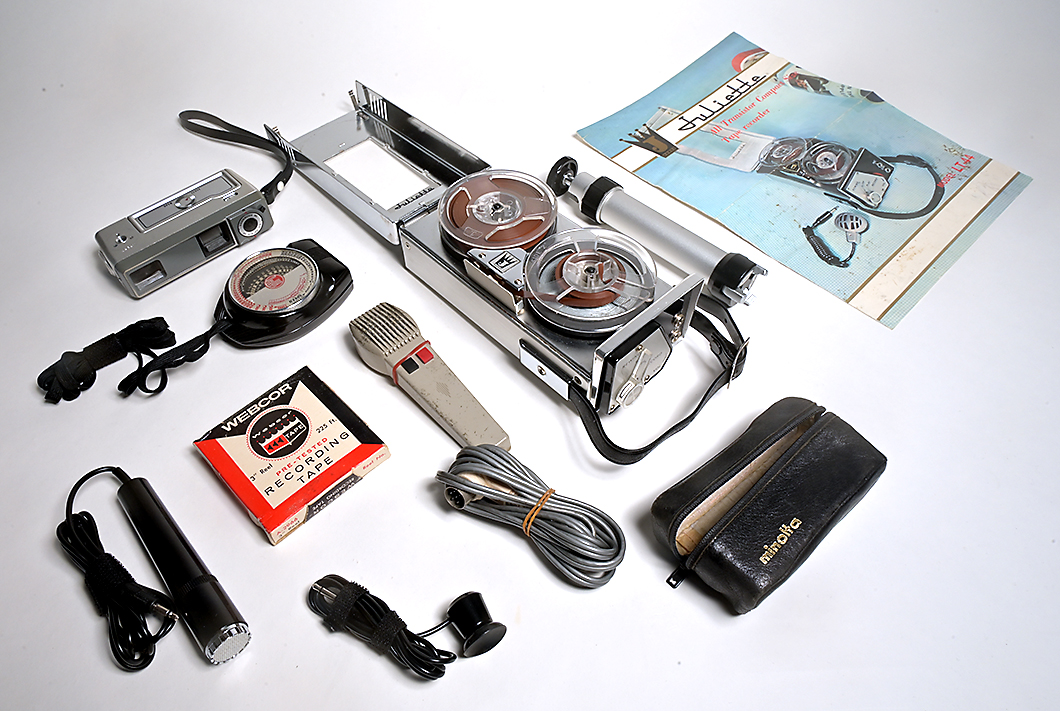
Girard Le Radieux
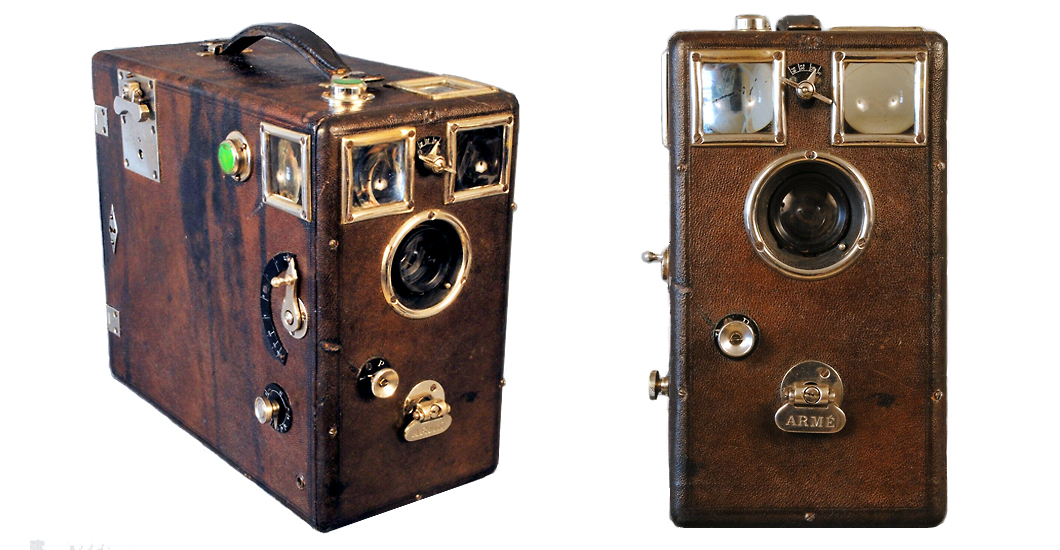
Girard "Le Radieux" (The Radiant) DETECTIVE Plate-Box Camera, cirka 1902. Laterna Magica Museum Collection.
Le Radieux (The Radiant) is a French detective plate-magazine box camera manufactured by Girard et Cie around 1900. J. Girard et Cie was located at 42, Rue de L'échiquier in Paris, not far from Gare du Nord.
The company used to sell different cameras under the same name, year after year. This Radiant could be used with twelve 9x12 cm glass plates or with 24 plan-film plates. It has several speeds, the fastest is 1/60 of a second. The shutter is cocked at the front with a selector marked "PP P and I" (PP may be for extended exposure), with a setting of the voltage graduated from 1 to 7 for the instantaneous speed.
The control diaphragms, speeds and focus are actuated by two fins integral with a tip-slider. One component helps to protect the lens during a rest period. The objective is a Roussel "Anti-Spectroscopic" and the focus goes down to one meter. It has two foot bolts in Congress pitch, two spirit levels, and a small key to close the plate magazine. The retraction of the plates is done by turning the lateral crank.
Girard appliances were often advertised in newspapers and periodicals around 1900. At the time, it costed 125 francs.
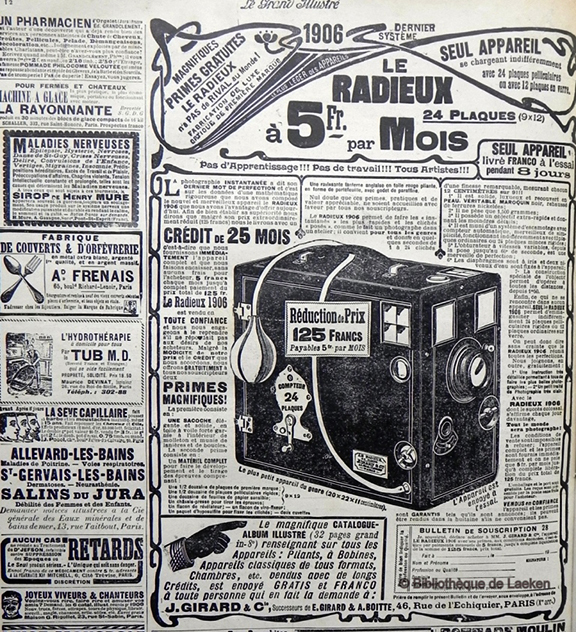
Newspaper advertisement of the 1906 model of "Le Radieux"
Zenit Photo Sniper Camera
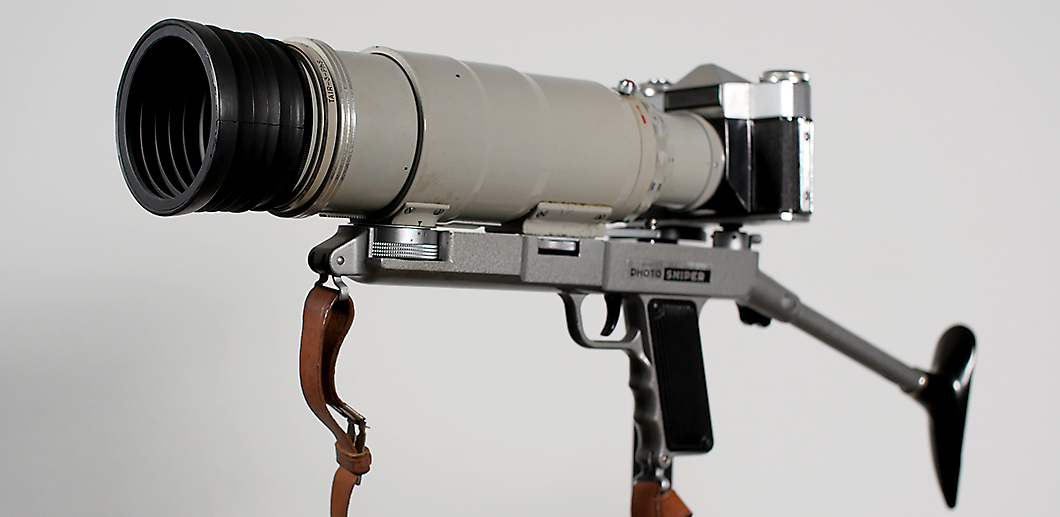
White Zenit Photo Sniper FS-3, ca. 1965. Laterna magica Museum Collection.
The Photo Sniper was first made in 1943-45 for military use by the Soviet forces. It was an observation camera with the look and feel of a rifle, which made it ideally suited for observation and surveillance tasks, as it enables the user to shoot steady images of distant or moving objects, such as people or cars passing by. The white Photo Sniper was used in light conditions like snow, and the black Photo Sniper in dark surroundings.
The camera was used by the KGB's 2nd Chief Directorate (counter intelligence), the KGB's 7th Directorate (surveillance), the Border
Guards and by East-European intelligence services like the East-German Stasi (MfS).
Later models were freely available as cameras for nature photographers, spies, and paparazzi. The FS-3 camera was supplied in a metal storage case, complete with telephoto and standard lenses, five color filters, spare films, a leather carrying strap, various tools, and the characteristic boom with the pistol grip and the removable shoulder stock.
Gun Sight Aim Point WWII Aerial Movie Camera
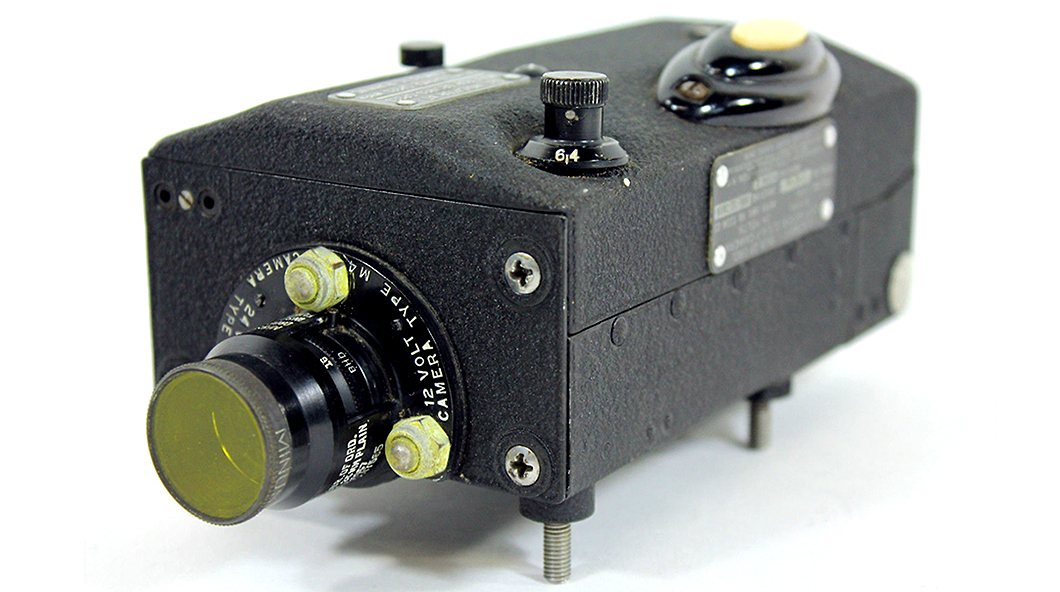
GSAP - Gun Sight Aim Point WWII 16mm Movie Camera Fairchild Aviation, ca. 1940. LATERNA MAGICA Museum Collection.
US Navy GSAP - Gun Sight Aim Point WWII 16mm Movie Camera by Fairchild Aviation.
From International Military Antiques: "G.S.A.P. (Gun Sight Aim Point) 16mm gun sight movie camera with 35mm 3.5 lens and yellow filter. This camera was the standard United States Army Air Force cine-gun camera during World War II. It was used mostly on fighter aircraft such as the P-51, P-47 and P-38 to record and confirm hits during air to air and air to ground gunnery. The camera operated only when the aircraft's gun trigger button was pressed. This type of camera was also fitted to the remote gun turret aiming controls of the Boeing B-29 heavy bomber.
Fighter pilots tended to make exaggerated claims of successful shoot downs of enemy aircraft, both due to misinterpretation of the
actual action and due to overinflated egos. To record the pilot’s actual success (or lack thereof) in shooting down a target, cameras were installed. These machine gun cameras were synchronized with the nose-mounted machine gun."
Provenance: From the estate of Ib Melchior, son of the renowned Danish opera star Lauritz Melchior. Ib served as an intelligence officer during World War II and was awarded a Silver Star for his capture of the infamous Nazi Werewolves. He later went on to become a noted author and science fiction screenwriter producing such films as Reptilicus and The Angry Red Planet.
Stylophot Pen Camera

Secam Stylophot camera, 1955. LATERNA MAGICA Museum Collection.
Manufactured by Secam in Paris 1955, the Stylophot was a unique type of subminiature camera. It could make 18 10×10mm exposures on double-perforated 16mm film in special cartridges. By pulling and
pushing the silver tab at the top you could advance the film. Advancing the film would tension the shutter and thus prevent double exposure.
GEC Radio Camera
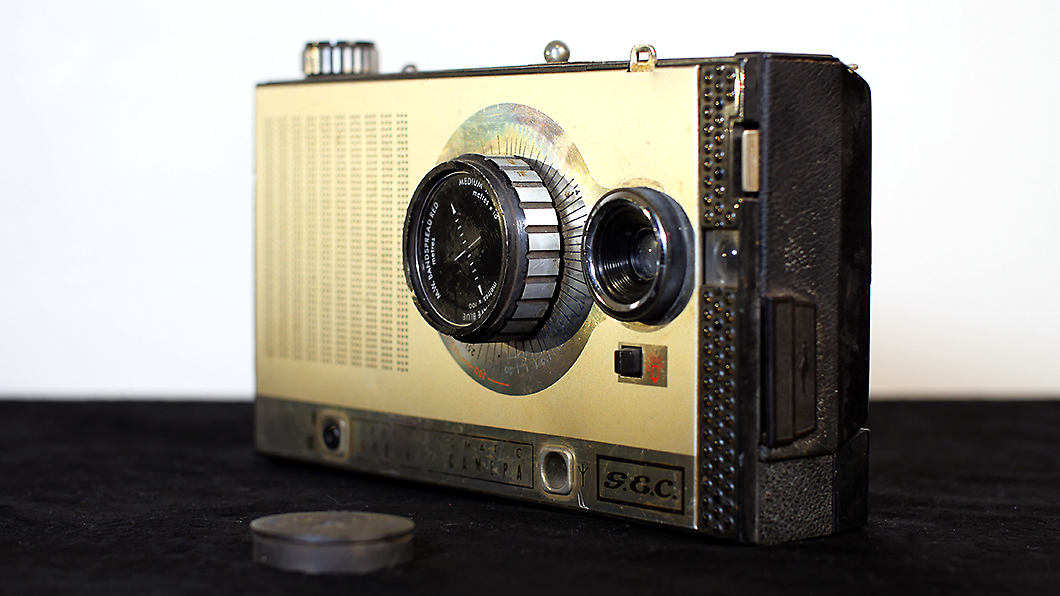
GEC Radio-Camera, 1964. laterna magica Museum Collection.
The culture of combining cameras with other objects like radios or lighters has existed since 1900.
The Kowa, a maker of both transistor radios and cameras, was the first to combine the two into one product, the Kowa Ramera Model KTC-62 (Konica Transistor Camera 16mm) from 1959. The GEC Radio Camera from 1964 is a combination of a General Electric Company radio and a Kodak Instamatic camera. The Kowa camera uses 16mm film in a special cassette, and the GEC Radio Camera uses 35mm film and comes with a hidden, built-in flash.
The back panel has to be moved to reveal the workings of the radio and access the battery chamber, both radios require one 9V battery. Both models have power/volume dial, the tuning dial, and a 2.5mm jack for earpiece.
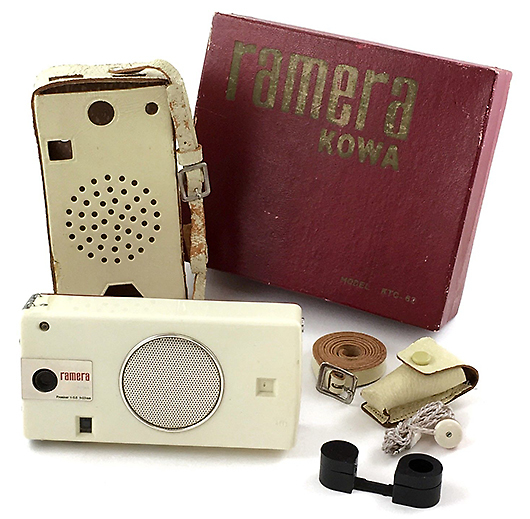
Lighter Camera

Camera-Lite, 1955. LATERNA MAGICA Museum Collection.
The Camera Lite is an unusual combination of a sub miniature cine camera for 6x6mm film concealed in a cigarette lighter. The camera came with a functioning flint/petrol ligther, which had to be opened in order to use the camera trigger.
In 1953 the Suzuki Optical Company’s Echo 8 sub miniature lighter/camera was featured in ‘Roman Holiday’ (Paramount Pictures). The film increased demand, which Suzuki could not keep up with. As a result they brought out the Camera Lite as a cheaper, simpler version of the Echo 8.
Filius von Isoplast Subminiature Camera
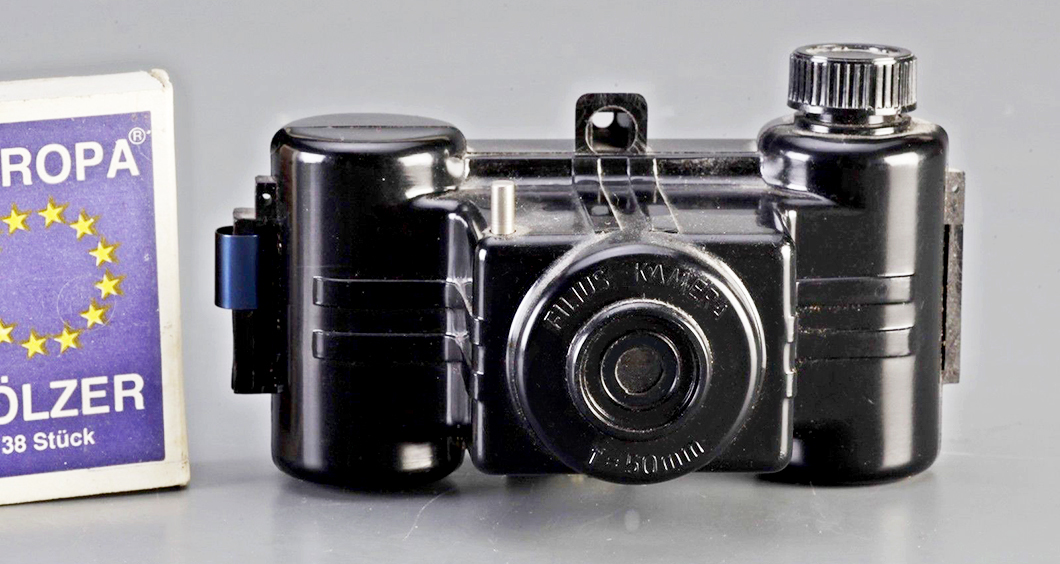
Filius von Isoplast Subminiature camera, 1954. Laterna Magica Museum Collection.
Subminiature espionage camera made from bakelite by Isoplast in Bad Godesberg, West Germany, 1954. It has fixed focus, single closure, a 50mm f/11 lens, fastest shutter speed at 1/50s, and manual exposure control. The camera used roll film 127 for 3x4 cm format, could focus at a distance of 2 meters, and was promoted as excellent for jumbo prints. Used during the Cold War by German agents.


